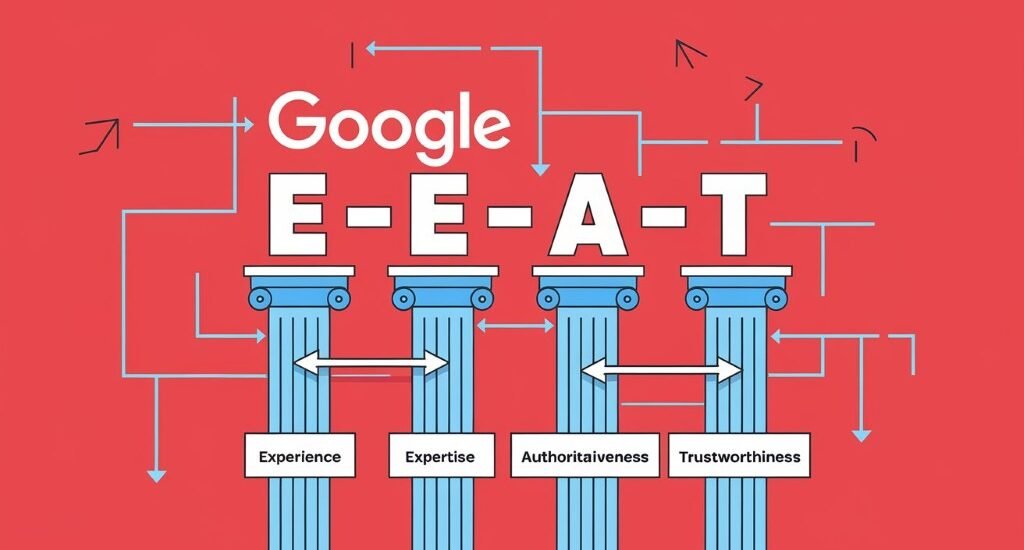In the ever-evolving landscape of Google Search, the focus remains steadfast on delivering helpful and reliable information to users. Google’s automated ranking systems are designed to prioritize content that is primarily created to benefit people, rather than solely to manipulate search engine rankings. Central to this evaluation is the concept of E-E-A-T: Experience, Expertise, Authoritativeness, and Trustworthiness. While not a direct ranking factor in itself, E-E-A-T represents the qualities that Google’s algorithms aim to identify and reward in high-quality content. This comprehensive guide will delve into each pillar of E-E-A-T and provide actionable strategies for creating people-first content that aligns with these crucial principles.
The Four Pillars of E-E-A-T: A Deep Dive
To effectively create content that resonates with both users and Google, a thorough understanding of each E-E-A-T element is essential.
A. Experience: Demonstrating First-Hand Knowledge
Experience, the newest addition to the E-E-A-T framework in December 2022, signifies Google’s increased emphasis on real-world, first-hand involvement with the subject matter. This goes beyond mere brand messaging, highlighting the value of authentic encounters and practical familiarity. Users often prioritize insights from individuals with direct, personal knowledge over generic claims. Genuine experience is also a quality that is inherently difficult for AI to replicate, making it a key differentiator for human-created content.
To effectively showcase your experience:
- Utilize original visuals: Employ your own images and videos rather than relying on stock photography, demonstrating actual engagement with the topic.
- Share personal perspectives: Incorporate personal insights, opinions, and anecdotes that can only stem from direct involvement.
- Include specific, unique details: Reference details and observations that an individual without first-hand experience would not know. For instance, a hotel review that mentions a specific view from a particular room or a unique interaction with staff provides stronger evidence of experience.
- Feature case studies and testimonials: Present real-world examples and feedback that illustrate practical application and results.
- Document product trials: For product reviews, detail the process, outcomes, and your personal assessment of using the product.
B. Expertise: Establishing Your Knowledge and Skills
Expertise within the context of E-E-A-T reflects the content creator’s level of knowledge or skill in a particular subject. Google recognizes both formal expertise, acquired through education, certifications, or professional experience, and informal expertise, gained through practical experience and demonstrable proficiency. The importance of demonstrating expertise is particularly heightened in YMYL (Your Money or Your Life) topics, where inaccurate information can have significant consequences for individuals’ health, financial stability, or safety.
Effective strategies for demonstrating expertise on your site include:
- Clearly showcase author credentials: Prominently display relevant qualifications, certifications, professional affiliations, and experience for all content creators. Author bios should be comprehensive and easily accessible.
- Create in-depth, well-researched content: Produce thorough and comprehensive pieces that demonstrate a deep understanding of the topic.
- Maintain niche focus and consistency: Regularly publish high-quality content within a specific area, establishing yourself as a knowledgeable resource.
- Demonstrate practical skills: Utilize videos, tutorials, or detailed explanations to showcase technical or hands-on abilities relevant to your expertise.
- Reference and cite authoritative sources: Back up your claims with links to credible research, data, and established authorities, clearly indicating the basis of your information.
C. Authoritativeness: Becoming a Go-To Source
Authoritativeness signifies the extent to which a content creator or website is recognized as a reputable and go-to source of information within their industry or niche. Unlike expertise, which focuses on individual knowledge, authoritativeness involves external validation and recognition from other credible entities. It is often built upon a foundation of strong experience and expertise, further amplified by how others perceive and reference your content.
Key strategies for building and demonstrating authoritativeness include:
- Earn high-quality backlinks: Acquire links from other authoritative websites within your industry, signaling that your content is valued and trusted by your peers. Tools like Semrush’s Backlink Gap tool can help identify potential linking opportunities.
- Gain mentions from industry leaders: Seek mentions, citations, and endorsements from influential figures and respected publications in your field. Engaging in digital PR can facilitate these opportunities.
- Secure press coverage and guest contributions: Contribute guest articles to reputable industry blogs and seek media features that highlight your expertise and brand.
- Create comprehensive, topically relevant content: Develop a strong content architecture that thoroughly covers all aspects of your niche, establishing topical authority. Keyword research tools like Semrush’s Keyword Magic Tool and Topic Research tool can aid in identifying relevant content areas.
- Cultivate a positive brand reputation: Actively manage your online presence and encourage positive reviews and testimonials. Respond to reviews professionally and transparently.
D. Trustworthiness: The Cornerstone of E-E-A-T
Trustworthiness is arguably the most critical element of E-E-A-T. Google emphasizes that untrustworthy pages will have low E-E-A-T regardless of their experience, expertise, or authoritativeness. Trustworthiness encompasses the accuracy, honesty, safety, and reliability of a website and its content. Google evaluates trust based on the content’s intended purpose, with YMYL topics demanding the highest levels of scrutiny.
Key factors that contribute to trustworthiness include:
- Transparent contact information: Provide easily accessible and accurate contact details, including a physical address (if applicable), phone number, and email address.
- Essential business policies: Ensure clear and readily available privacy policies, terms and conditions, cookie policies, and return policies (for e-commerce sites).
- Website security: Implement HTTPS and SSL encryption to safeguard user data and financial transactions. Regularly check your site’s security using tools like Semrush’s Site Audit.
- Accurate and well-researched content with citations: Present factual information supported by credible sources, clearly citing all references. Maintain a commitment to accuracy and avoid misleading information.
- Fair and balanced customer reviews and testimonials: Display genuine feedback from users, both positive and negative, demonstrating transparency and accountability.
- Clear advertising disclosures: If your site includes advertising or sponsored content, ensure it is clearly and conspicuously disclosed to users.
- Up-to-date content: Regularly review and update your content to ensure accuracy and relevance, clearly indicating the last updated date.
- Display trust signals: Showcase industry memberships, security seals, and recognition from reputable organizations.
- Showcase press mentions: Highlight logos of press publications where your brand or experts have been featured.
Putting E-E-A-T into Practice: Creating People-First Content
Implementing E-E-A-T effectively requires a fundamental shift towards creating people-first content, content designed primarily to be helpful and informative for your audience.
- Focus on user needs and search intent: Understand what your audience is looking for and create content that directly addresses their queries and provides comprehensive solutions.
- Self-assess your content: Regularly evaluate your existing and new content against the questions outlined by Google to gauge its helpfulness and reliability. Consider seeking honest feedback from unaffiliated individuals.
- Ask the “Who, How, and Why” of your content:
- Who created the content? Ensure clear authorship with detailed author bios that establish their experience and expertise. Avoid authorless content.
- How was the content created? Be transparent about the content creation process, including the use of automation or AI, with appropriate disclosures.
- Why was the content created? Prioritize creating content to genuinely help people, not solely to attract search engine traffic.
- Add value beyond existing content (“Information Gain”): Strive to offer original insights, research, analysis, or reporting that goes beyond simply summarizing existing information.
- Optimize User Experience (UX) as a Trust Signal: A positive user experience contributes to trustworthiness. Ensure your website is user-friendly, accessible, and provides a seamless browsing experience.
Common Misconceptions and Challenges of E-E-A-T
It’s important to clarify some common misunderstandings surrounding E-E-A-T.
- E-E-A-T is not a direct ranking factor: While crucial for high-quality content that Google aims to reward, E-E-A-T itself is not a quantifiable metric in the ranking algorithm.
- E-E-A-T is more than just a checklist: Building and demonstrating E-E-A-T is a nuanced process that varies across industries and niches.
- E-E-A-T in different niches: The specific ways to demonstrate E-E-A-T will differ depending on the topic, with YMYL topics requiring particularly stringent standards.
- E-E-A-T and User-Generated Content (UGC): While standards may be looser for UGC, moderation is essential to prevent spam, hateful content, or misinformation, which can negatively impact overall site trustworthiness.
- You cannot “fake” E-E-A-T: Authenticity is paramount. Attempting to fabricate experience, expertise, authoritativeness, or trustworthiness will likely be identified and will undermine your credibility.
- Addressing authorless content: Strive to assign clear authorship to all content. If experts cannot write directly, collaborate with them for quotes, reviews, or co-authorship.
- Overcoming resource constraints: Building E-E-A-T takes time and effort. Prioritize key areas and explore creative solutions for leveraging internal expertise.
- AI and E-E-A-T: While AI can assist in content creation, it cannot inherently demonstrate genuine experience, expertise, or authoritativeness. Transparency about AI usage and rigorous human review are crucial for maintaining trust. Google’s stance is that AI-generated content is not prohibited as long as it doesn’t manipulate rankings and prioritizes quality.
The Role of SEO in Supporting E-E-A-T
Search Engine Optimization (SEO) plays a vital role in ensuring that your high-E-E-A-T content is discoverable by the right audience.
- SEO enhances discoverability: Optimizing your content structure, metadata, and keywords helps search engines understand and surface your valuable, E-E-A-T-rich content.
- Internal linking showcases topical authority: Strategically linking related content on your site reinforces your expertise and authority within a subject area.
- Earning backlinks from authoritative sources: As discussed, backlinks are a key signal of authoritativeness and contribute to SEO performance.
- Schema markup highlights authorship and expertise: Utilizing schema markup can help search engines better understand the authors and their credentials, further supporting E-E-A-T signals.
Measuring and Monitoring Your E-E-A-T Efforts
Directly quantifying E-E-A-T can be challenging as it is not a specific metric. However, several key metrics can correlate with improvements in E-E-A-T:
- Organic traffic and rankings: Improved visibility in search results often reflects Google’s recognition of your content’s quality and trustworthiness.
- User engagement metrics: Higher time on page, lower bounce rates, and increased page views can indicate that users find your content valuable and trustworthy.
- Brand mentions and sentiment: Monitoring online mentions of your brand can provide insights into your perceived authority and trustworthiness.
- Backlink profile growth and quality: An increasing number of backlinks from reputable sources signals growing authoritativeness.
- Customer reviews and ratings: Positive feedback contributes to your overall trust and reputation.
Utilize tools like Google Search Console, Google Analytics, and brand monitoring platforms to track these relevant metrics. Regularly audit your content and E-E-A-T signals to identify areas for improvement.
Conclusion: E-E-A-T as a Long-Term Strategy for Sustainable Success
Building strong E-E-A-T is not a one-time task but rather an ongoing commitment to creating valuable, reliable, and people-first content. By prioritizing experience, expertise, authoritativeness, and trustworthiness in your content creation process, you will not only align with Google’s guidelines but also build lasting trust with your audience, leading to improved search visibility and long-term success. Embrace the principles of E-E-A-T as a foundational element of your content strategy and continuously strive to provide the best possible experience for your users.



